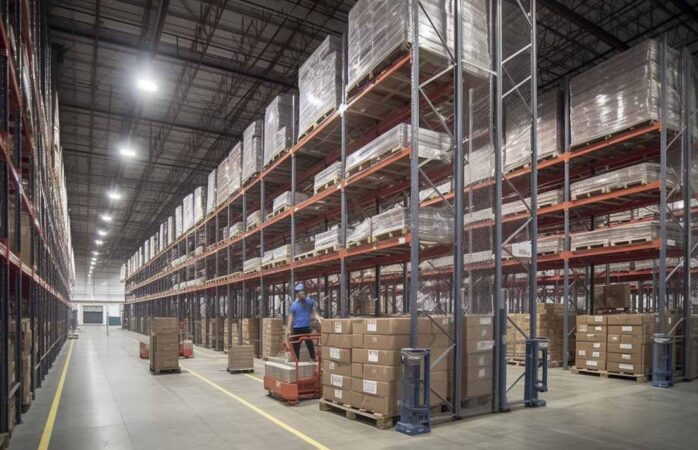In the vast landscape of global commerce, the flow of goods from producers to consumers is a complex dance, choreographed with precision and strategy.
At the heart of this dance is logistics. It is a discipline often operating behind the scenes, yet integral to ensuring that products reach their intended destinations in a timely and efficient manner.
While many appreciate the end result, receiving a desired item at their doorstep or store shelf, the intricate processes and decisions that facilitate such outcomes often remain shrouded in mystery.
This article aims to illuminate the nuances of this critical field, delving into its pivotal role in connecting businesses, markets, and consumers across the world.
In an age where efficiency and speed are pivotal to success, understanding the role of logistics in distribution is more critical than ever.
Our comprehensive guide explores the complex world of distribution logistics, from its historical evolution to its symbiotic relationship with supply chain management.
Whether you’re a business owner striving for operational excellence or a curious reader, this blog post will equip you with the insights you need to comprehend how logistics shapes our world of commerce.
Keep reading to learn more.
Unveiling Logistics: A Comprehensive Definition

Logistics is the art and science of strategically coordinating the movement and storage of goods, services, and pertinent information from the point of origin to the end consumer.
This intricate process encompasses elements such as material handling, inventory optimisation, order processing, and transportation strategy.
Emergence and Evolution of Logistics
The history of logistics has evolved considerably to adapt to the changing landscape of business and technology.
Originating from military contexts where it focused solely on the transportation of troops and supplies, logistics underwent a significant transformation during the Industrial Revolution.
The advent of steam engines and railways enabled more complex supply chains, leading to the inclusion of inventory management and warehousing as key components.
Recent years have seen a focus on sustainability and the integration of emerging technologies.
Companies are exploring eco-friendly transportation options and waste-reducing strategies, while advancements in Artificial Intelligence, blockchain, and the Internet of Things promise to bring further innovation.
In essence, logistics has transitioned from a basic function of moving goods to a complex, technology-driven field integral to global commerce.
Logistics vs Supply Chain Management
Logistics and Supply Chain Management (SCM) are closely related but distinct aspects of business operations. Logistics focuses on the efficient movement and storage of goods from the point of origin to the consumer, covering functions like transportation, warehousing, and inventory management.
In contrast, SCM takes a broader view, overseeing the entire product lifecycle from raw material sourcing to production and final delivery. While logistics is concerned with the operational details of moving goods, SCM aims to optimise the entire chain, integrating functions such as procurement and production planning.
Essentially, logistics is a subset of the more comprehensive field of supply chain management.
Anatomy of the Supply Chain

The supply chain, guided by the company’s supply chain processes, is a complex network involving the supplier, retailer, and consumer, where logistics plays a significant role.
Role of Logistics in Supply Chain
Logistics is a critical component within the supply chain, acting as the operational engine that drives the movement of goods. It encompasses a range of activities such as transportation, warehousing, inventory management, and order fulfillment.
Logistics ensures the seamless flow of raw materials from suppliers to manufacturers and the efficient distribution of finished goods to retailers and consumers. It plays a pivotal role in meeting customer demands, reducing lead times, and minimizing storage costs.
Importance of a Robust Supply Chain in Successful Logistics
A well-structured and robust supply chain is indispensable for the success of logistics operations. It provides the framework within which logistics functions, ensuring that each component – from raw material procurement to consumer delivery – is synchronized and efficient.
A weak or fragmented supply chain can lead to bottlenecks, delays, and increased costs, adversely affecting logistics. Therefore, a strong supply chain is essential for optimizing logistics operations, enabling the smooth flow and distribution of goods.
In summary, logistics is an integral part of the supply chain, responsible for the effective movement and storage of goods. Its efficiency is heavily reliant on a robust supply chain, which provides the necessary structure and coordination for successful logistics operations.
The Core Function of Logistics in Distribution
Inventory management, warehouse management, and transportation strategy form the core functions of logistics in distribution. Here’s how they each play their role in distribution:
- Inventory Management and Order Fulfillment: Proper inventory control helps optimize order fulfillment while reducing shipping costs. These logistics activities are crucial for ensuring the efficient distribution of goods.
- Warehouse Management: A strategic warehouse management system is key to streamlining the logistics process. It ensures the safe storage and effective outbound logistics of goods for delivery.
- Effective Transportation Strategies: Effective transportation management system helps in quick and safe movement of goods from warehouse to distributor or retailer, ensuring smooth logistics operations.
Role of Distribution Centres in Streamlining Logistics

Distribution centers play an essential role in improving logistics efficiency, offering third-party logistics and indirect distribution.
Overview of a Distribution Centre
A distribution center, also called a distribution centre, is a storage facility where goods are stored for a short time before being shipped to retailers. It’s a critical component of the logistics network.
Functionality of a Distribution Centre within Logistics
Within logistics, a distribution centre serves as a critical hub for managing the flow of goods.
- Receiving Inbound Shipments: The centre receives and sorts inbound shipments from suppliers or manufacturers, often conducting quality checks upon arrival.
- Storing Goods: Goods are stored in designated areas, with advanced centres using automated systems for efficient retrieval.
- Inventory Management: Real-time tracking systems monitor inventory levels to prevent stockouts or overstocking.
- Order Processing and Picking: Orders are processed by picking required items from storage, which are then packed for shipping.
- Dispatching Outbound Orders: Finally, the centre dispatches outbound orders to retailers or directly to consumers, coordinating with various transportation options for timely delivery.
In essence, the distribution centre performs key functions from receiving and storing goods to managing inventory and dispatching orders, making it integral to effective logistics.
Navigating Supply Chain Management and Logistics Management
Understanding the close relationship and differences between supply chain management and logistics management is key to efficient movement and distribution of goods.
Understanding the Differences and Similarities
Though similar, logistics management focuses on internal organization activities whereas supply chain management takes a broader perspective, including suppliers, manufacturers, and retailers.
Impact on Distribution and Order Fulfillment
Logistics directly influences order fulfilment and distribution by managing the internal flow of goods.
It handles both direct distribution to consumers and indirect distribution through intermediaries like wholesalers. SCM, on the other hand, impacts these areas on a macro level by optimising the entire chain, which inherently includes logistics.
Importance of Logistics in Indirect Distribution

Indirect distribution involves third-party intermediaries like warehouse centers and distribution centers. In such cases, logistics ensures goods reach from suppliers to distributors and, eventually, to customers efficiently.
Defining Indirect Distribution
Indirect distribution employs intermediaries to deliver goods to your market, such as logistics companies, wholesalers, and distribution centers. This method is especially beneficial for businesses unable to reach their market directly.
Implementation of Logistics in Indirect Distribution
In the context of indirect distribution, logistics plays a vital role in ensuring efficiency and accuracy. It manages shipping, oversees warehouse operations, and coordinates with intermediaries to guarantee that goods are dispatched to the correct destinations.
Logistics also provides tracking and inventory management to maintain visibility and control throughout the distribution process.
Logistics Explained: Improving Efficiency and Productivity
In today’s competitive business landscape, optimizing logistics is crucial for enhancing both efficiency and productivity. Leveraging strategic planning, operational management, and cutting-edge technology is essential for achieving these goals.
Let’s take a look at the key components that elevate a company’s logistics operations to new levels of effectiveness:
- Strategic Planning: Strategic planning in logistics involves designing a roadmap for movement and storage of goods. Having a robust logistics strategy enhances efficiency, reduces cost and increases customer satisfaction.
- Operational Management: Operational Management involves overseeing logistics operations on an everyday basis. This includes tasks such as material handling, inventory management, transportation management, and more.
- Information Technology and Digitization: In today’s digital age, logistics management has increasingly incorporated IT solutions for accurate tracking, inventory control, and efficient ship management. This digitization has revolutionized logistics operations.
Key Takeaways & Wrap Up

Effectively integrating logistics into supply chain management and distribution systems has transformative effects on business operations. It enhances efficiency, curtails costs, and speeds up delivery times, thereby offering a competitive edge.
1. Challenges and Future Prospects
While logistics offers numerous benefits, it’s not without challenges such as regulatory hurdles and vulnerabilities in the supply chain.
However, the future looks promising with emerging technologies like Artificial Intelligence (AI) and blockchain poised to address these issues and optimise logistics operations.
2. Relevance in Today’s Business Landscape
The digital era has amplified the importance of logistics, especially for e-commerce businesses and sectors requiring fast and secure deliveries. Innovations like reverse logistics, which streamline returns and replacements, demonstrate the adaptability and critical role of logistics in modern distribution systems.
3. Emergence and Evolution of Logistics
Logistics has evolved from its rudimentary military origins to a complex, technology-driven field. The Industrial Revolution marked its first major transformation, followed by globalisation and the digital age, each adding layers of complexity and capability.
4. Logistics vs Supply Chain Management
While logistics focuses on the internal operations of moving and storing goods, supply chain management encompasses a broader range, from raw material sourcing to end consumer delivery.
Logistics is a subset of supply chain management, and both are interdependent for achieving efficient distribution and order fulfilment.



















